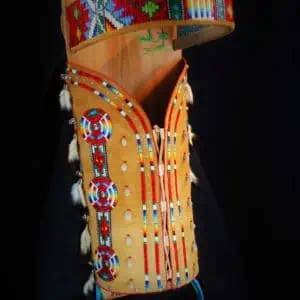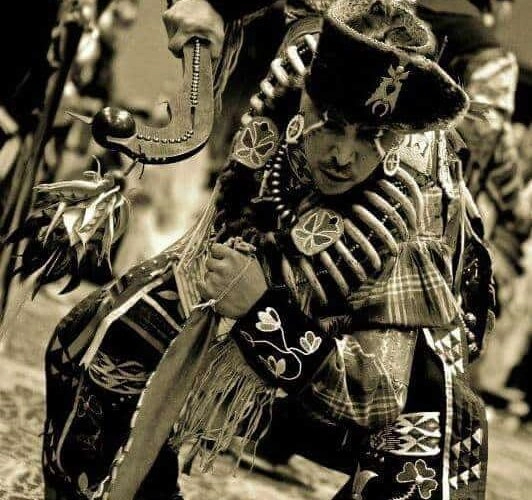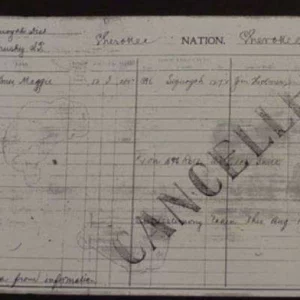Dana Warrington needs little introduction on the powwow trail. He’s a champion traditional dancer, arena director, and an all-around talent representing both the Menominee Tribe of Wisconsin and the Prairie Band of Potawatomi of Kansas.
Dana is enrolled with the Prairie Band of Potawatomi of Kansas but grew up on the Menominee Indian Reservation in Northern Wisconsin among his father’s side of the family. And while it’s fair to assume his mother’s family resides states away in Kansas, his mother’s relatives resettled to the State of Wisconsin in the early 1900’s to a small place that what would become the Powers Bluff State Park. Prior to the existence of the State Park, a group of Prairie Band Potawatomi members resided there and called their place of settlement Skunk Hill. So, Dana says, he was very fortunate that he was able to spend a lot of time with both sides of his family in the State of Wisconsin.
He’s a traditional artist inspired by generations of his family but credits his main inspiration to his maternal grandmother Dorothy Young. Dana’s many mediums include beadwork, quillwork, bustle-making, moccasins, and cradleboards. His journey to becoming an award-winning artist and business owner was decades in the making and is taking a turn that’s blazing a trail he could have never imagined.

Dana has been powwow dancing since he could walk. He recalls creating smaller craft items when he was 7 years old with his first interest being colored electrical tape. “I thought colored electrical tape was so cool,” says Dana.
It wasn’t until he was 17 that he began taking art more seriously. He says his mother Becky Warrington urged him to start making his own dance outfits and recalls her expressing that if he challenged himself to make an outfit that he could accomplish anything he put his mind to. So, for several years, he took to beading in the winter months and produced an entire dance outfit approaching each summer powwow season. And with each passing season, people noticed and started inquiring who made his outfits only to find out he did. And by the age of 20, Dana received his first commission to bead an entire dance outfit.
It was in 2011 where Dana’s art took a turn—he started creating with porcupine quills, which is an art form that predates the arrival of Europeans to the Americas.
Dana says his adjustment to quillwork was inspired by purchasing a pipe bag and a scalplock—the backing of a dance roach—that included quills. “When I realized how amazing these items were up-close, is when I became fascinated with quillwork,” says Dana. “Knowing as a parent I won’t always be able to afford expensive items for myself is when I became influenced to learn how to quill myself.”
And as Dana recalls, it was a year of trial and error before he started showcasing his own quillwork. During that time, he says he invested a lot, acquiring crafts and materials while learning from videos to perfect his approach. And in November of 2012, while attending the Poarch Creek Indian Powwow in Louisiana, is when he first attempted to sell his own quillwork only to realize he sold out of his entire stock in less than 30 minutes.
“With the success at Poarch Creek, orders for quillwork have been in demand,” says Dana. “That is when I realized I could start a business featuring my quillwork and launched Native Expressions Quillwork.”

With the launching of Native Expressions Quillwork, Dana’s work week turned into 60 hours per week and his dancing started slowing down. But Dana invested in his craft and his business. Residing in Cherokee, North Carolina, he took some business development classes so that he could gain better knowledge and skills to continue to develop his business so that it continues to be sustainable.
2017 was a memorable year for Dana. It was the first time he submitted his artwork to a juried art show and won not only once, but three times!
“I was invited to the Eiteljorg Indian Art Market as a featured artist and realized they didn’t have a category for quillwork,” says Dana. He originally had hopes to submit his quillwork in the subsequent category and was completely surprised with the award of “Best of Show,” which is the highest award at one of the most prestigious American Indian Art Markets in the country.

“When Eiteljorg awarded me ‘Best of Show’ I didn’t understand what it meant,” he continues. From the thrilling accomplishment, he realized that pursuing art shows would be his new passion and prepared overtime for his first Santa Fe Indian Art Market appearance. He worked 10 to 14 hour days in the 6 weeks between the Eiteljorg Indian Art Market and the Santa Fe Indian Art Market where he was able to create a quilled cradleboard and a full-size pipe bag. Both won. His cradleboard won 1st place in the cradleboard category and his pipe bag won 2nd place in accessories.
During his first year pursuing art shows, Dana expressed the excitement in his experience.
“Looking back to this year, my head spins,” says Dana. “It seemed everything happened too fast. But then I realized I could do the artwork if I pushed myself.”
His local participation in business development classes at the Sequoia Fund in Cherokee, North Carolina came with recognition from the Eastern Band of Cherokee—he became eligible for tribal loans. So, he applied for a business loan and was awarded $25,000 to help build his own artist studio!

“Since I started creating, I’ve always created in the corner of a room or at a random table,” says Dana. “Now I have my own studio, making what I saw my grandmother making so many years ago. It’s a dream come true.”
His art studio is one major accomplishment and is bound to be completed on December 24, 2017.
As Dana prepares for his future, he shares that in 2018 he’s going to submit for six separate art shows. They are the Heard Museum’s Indian Fair & Market in Phoenix, Arizona during the month of March, the Eiteljorg Indian Art Market in Indianapolis, Indiana during the month of June, the Santa Fe Indian Art Market in August, the Cherokee Indian Art Market in Tulsa, Oklahoma during the month of August, the National Museum of American Indian’s Native Art Market in New York City, and the Santa Fe Winter Art Market both in December.
“Moving forward, I don’t think I’ll ever do that many Indian Markets, but I can say I did that many,” says Dana. “In future years, I think I’ll limit my market appearances to only three per year.”
He says his next medium he’d like to learn one day is silver work, hoping to blend silver and quills creating entirely new pieces. His next steps include creating and launching his own website to continue showcase and share his art and journey with the wider world and to one day create scholarships for the youth and upcoming artists.
“There's nothing more I'd like to do then give back to our people,” says Dana. “Sharing this journey is a blessing and I thank everyone for supporting all of our arts.”
You can catch Dana at the above-mentioned art shows in the next year, learn from his workshops, residences, and how-to classes all through his social media at Native Expressions Quillwork.




